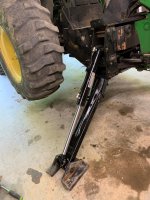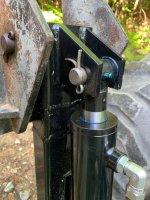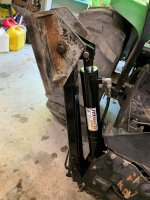I'm creating this thread to document how a stabilizer cylinder was replaced on my model 48 backhoe using an aftermarket cylinder.
Why replace the cylinder? I was sloppy and nicked the chrome with one of the backhoe teeth. I was careful to immediately clean up the protrusion created by the nick, and that didn't seem to create a problem. However, I think it may be one of son-in-laws hit something with it and created a terrible scrape on the side of the chrome rod. I didn't notice it, and that scrape acted like a file to chew up the seal. In a short time, the cylinder was leaking profusely.
I chose to not bother with JD (they will want a small fortune) since I could pick up a brand new cylinder from Magister for $170 including shipping, and modifications were fairly simple to work through. The biggest issue was that the original cylinder is 22" retracted, but the closest aftermarket cylinder is 24" retracted. Additionally, the JD original is a 15" stroke, while aftermarket is 16". My goal was to be able to easily replace the cylinder, since this is very likely to happen again with multiple people running the machine, so I don't mind tweaking the machine to make it compatible with an aftermarket part. I preferred to use a cylinder with the Tang ends, but that was out of stock, and I had a time-crunch to get the machine running again. Here's the link for the cross-tube cylinder used:

 www.magisterhyd.com
www.magisterhyd.com
To deal with that extra retracted length, the stabilizer arm was removed, and extended by 2". Bushings for the pins had to be made because the stock pin is 7/8", while the cylinder pin bores are 1". How does JD come up with such a strange pin size??? The cross tubes had to be trimmed a little bit to fit the width of the stabilizer arm.
Here are some pics of the installed cylinder.
If you look closely, you will see the two welds near the foot where the stabilizer tube was cut, and a 2" section of tube was welded in. Some fresh paint makes it look pretty. I need to paint the foot so it's pretty too (yeah, like that matters).
One final note: If you look closely at the photos, you will see that I had to remove one of the bolts that secures the backhoe to the tractor mount. This bolt interferes with the hydraulic elbow fitting. I'm not terribly worried since this is one of 7 bolts that hold that together. I picked up a shorter bolt that doesn't span the full width, but will still secure the two parts together. You'll have to study the photos to figure out what I'm talking about here. In the photos, the new bolt is not yet installed.
Why replace the cylinder? I was sloppy and nicked the chrome with one of the backhoe teeth. I was careful to immediately clean up the protrusion created by the nick, and that didn't seem to create a problem. However, I think it may be one of son-in-laws hit something with it and created a terrible scrape on the side of the chrome rod. I didn't notice it, and that scrape acted like a file to chew up the seal. In a short time, the cylinder was leaking profusely.
I chose to not bother with JD (they will want a small fortune) since I could pick up a brand new cylinder from Magister for $170 including shipping, and modifications were fairly simple to work through. The biggest issue was that the original cylinder is 22" retracted, but the closest aftermarket cylinder is 24" retracted. Additionally, the JD original is a 15" stroke, while aftermarket is 16". My goal was to be able to easily replace the cylinder, since this is very likely to happen again with multiple people running the machine, so I don't mind tweaking the machine to make it compatible with an aftermarket part. I preferred to use a cylinder with the Tang ends, but that was out of stock, and I had a time-crunch to get the machine running again. Here's the link for the cross-tube cylinder used:

2.5 bore x 16 stroke hydraulic cylinder, welded cross tube double acting cylinder | Magister Hydraulics
2.5" bore x 16" stroke cross tube hydraulic cylinder 3500 PSI. Heavy-duty hydraulics, 2-year warranty, free ground Continental US shipping. Magister cylinders manufactured using steel piston and steel threaded gland with wear rings for long life. Welded cross tube ends, honed cold-drawn tubing...
 www.magisterhyd.com
www.magisterhyd.com
To deal with that extra retracted length, the stabilizer arm was removed, and extended by 2". Bushings for the pins had to be made because the stock pin is 7/8", while the cylinder pin bores are 1". How does JD come up with such a strange pin size??? The cross tubes had to be trimmed a little bit to fit the width of the stabilizer arm.
Here are some pics of the installed cylinder.
If you look closely, you will see the two welds near the foot where the stabilizer tube was cut, and a 2" section of tube was welded in. Some fresh paint makes it look pretty. I need to paint the foot so it's pretty too (yeah, like that matters).
One final note: If you look closely at the photos, you will see that I had to remove one of the bolts that secures the backhoe to the tractor mount. This bolt interferes with the hydraulic elbow fitting. I'm not terribly worried since this is one of 7 bolts that hold that together. I picked up a shorter bolt that doesn't span the full width, but will still secure the two parts together. You'll have to study the photos to figure out what I'm talking about here. In the photos, the new bolt is not yet installed.
Attachments
Last edited:


